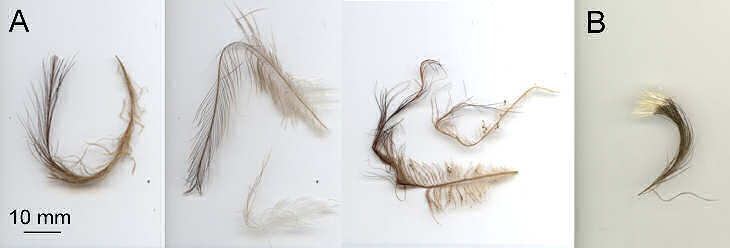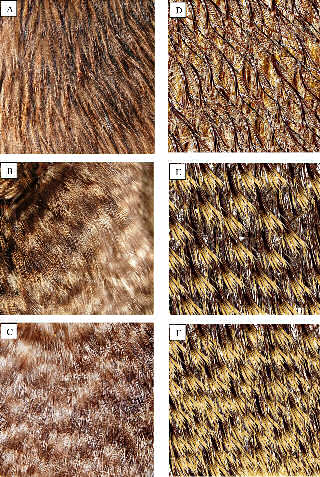|
|
Including the dominant giant Moa (about 3.7 m (12 ft) in height with neck outstretched, and weighed about 230 kg (510 lb)), 41 per cent of New Zealandís breeding bird species were annihilated with the first arrival of humans in 1280 AD.
These species are relatively well known because of New Zealandís rich fossil records. A few partially mummified remains have also been found and isolated feathers have been recovered from prehistoric rockshelter sediments.
Ancient DNA can be a powerful tool for reconstructing the appearance of species. Eg. for reconstructing mammoth and horse coat colour. However, these studies used ancient DNA to identify colour genes, rather than directly linking hair samples of known colour to an extinct species of unknown external appearance.
The subfossil moa feathers were analysed and it was discovered that mtDNA can be amplified whence it was demonstrated that both ancient DNA and plumage information can be recovered from their upper portion, allowing species identification and a means to reconstruct the appearance of extinct taxa.
Lastly, to determine whether moa feathers could be used to reconstruct plumage characteristics, the amount of colour fading was quantified digitally by comparing subfossil feathers from another species recovered from the same deposits with living relatives.
Four species of Moa were identified: Upland moa, South Island Giant Moa, Stout-legged Moa and Heavy-footed Moa.
 Figure
1. Characteristic morphology and colour of moa feathers identified from ancient
DNA sequences. (a) Feathers identified as upland moa (M. didinus), South Island
giant moa (D. robustus), stout-legged moa (E. gravis) and heavy-footed moa
(P. elephantopus) exhibited overlapping morphology and colour. The three best
examples are shown. From left to right: upland moa (OM Av10793.1), upland
moa (OM Av10791.1), South Island giant moa (OM Av10793.2). (b) White-tipped
feather (A 06.49.18) identified as heavy-footed moa. Scale bar, 10 mm.
Figure
1. Characteristic morphology and colour of moa feathers identified from ancient
DNA sequences. (a) Feathers identified as upland moa (M. didinus), South Island
giant moa (D. robustus), stout-legged moa (E. gravis) and heavy-footed moa
(P. elephantopus) exhibited overlapping morphology and colour. The three best
examples are shown. From left to right: upland moa (OM Av10793.1), upland
moa (OM Av10791.1), South Island giant moa (OM Av10793.2). (b) White-tipped
feather (A 06.49.18) identified as heavy-footed moa. Scale bar, 10 mm.
 Figure
2. (a) Plumage of brown kiwi (A. australis); (b) plumage of great-spotted
kiwi (A. haastii); (c) plumage of little-spotted kiwi (A. oweni); (d) reconstruction
of upland moa (M. didinus), South Island giant moa (D. robustus), stout-legged
moa (E. gravis) and heavy-footed moa (P. elephantopus) plumage based on a
dark feather; (e and f ) reconstruction of upland moa and heavy footed moa
plumage based on white-tipped feathers, (e) densely and ( f ) sparsely spaced.
Figure
2. (a) Plumage of brown kiwi (A. australis); (b) plumage of great-spotted
kiwi (A. haastii); (c) plumage of little-spotted kiwi (A. oweni); (d) reconstruction
of upland moa (M. didinus), South Island giant moa (D. robustus), stout-legged
moa (E. gravis) and heavy-footed moa (P. elephantopus) plumage based on a
dark feather; (e and f ) reconstruction of upland moa and heavy footed moa
plumage based on white-tipped feathers, (e) densely and ( f ) sparsely spaced.
The identification provided unique insights into the appearance of these species, the most striking is that some Heavy-footed Moa appear to have had a speckled appearance.
It is likely that the convergent colouring of some moa feathers has been driven by selection on plumage to avoid predation by aerial predators such as Haastsí eagle.
Subfossil and museum feathers represent a valuable untapped resource of genetic information. In addition, the presence of DNA in the rachis and barbs of moa and modern emu feathers suggests that multiple parts of a feather may contain DNA, providing a method for genetic analysis requiring minimal destruction of valuable specimens.
"There are so many enigmatic extinct species that it would be great to see `clothed'," Professor Cooper says.
Contact: Nicolas Rawlence
nicolas.rawlence@adelaide.edu.au
61-406-973-557
University of Adelaide